Building Your Spiritual Foundations
Building your spiritual foundations
“Remember the former things of old: for I am God, and there is none else; I am God, and there is none like me,
Declaring the end from the beginning, and from ancient times the things that are not yet done, saying, My counsel shall stand, and I will do all my pleasure: Isaiah 46:9 ,10″
“In the beginning God created the heaven and the earth.Genesis 1:1”
God declares His existence in the very first verse of the Bible, He is our maker and He declares the end from the beginning that we may know he is true and faithful and that we can have confidence in His promises. Building your spiritual foundations
 For many the bible will make no sense until we reach out and seek His ministration, that we might come to know and to fear the Lord. We need to prayerfully seek Him, and desire change in our lives that He may begin His ministration in our hearts. Once the door to understanding the scriptures is opened to us then we will see the evidence of His works, in us, as well as around us.
For many the bible will make no sense until we reach out and seek His ministration, that we might come to know and to fear the Lord. We need to prayerfully seek Him, and desire change in our lives that He may begin His ministration in our hearts. Once the door to understanding the scriptures is opened to us then we will see the evidence of His works, in us, as well as around us.
The human mind suffers from a common ailment in that we have difficulty discerning the trees for the forest, and consequently our eyes are blinded to the wonders of His creation.
The carnal mind is at enmity with God and therefor cannot see the things of God, and we instinctively know that if we have our backs turned to Him, then we must deceive ourselves and be convinced that He does not exist.
“For they that are after the flesh do mind the things of the flesh; but they that are after the Spirit the things of the Spirit.
For to be carnally minded is death; but to be spiritually minded is life and peace.
Because the carnal mind is enmity against God: for it is not subject to the law of God, neither indeed can be. Romans 8:5-7″
 If this is your condition then please take the time to consider your position carefully as while you still draw breath it is not too late.
If this is your condition then please take the time to consider your position carefully as while you still draw breath it is not too late.
The physical evidence for God’s existence is beyond the comprehension of our finite minds, and yet we still deny Him, and this is true also for many believers that have given themselves by faith, but God has given ample evidence of His existence to convict even the most proud of heart.
For those that do wish to know God, you only need to read His Word, if you do so then you will know. The prophecies in the Bible make up some 27% of the Book of which there are thousands that have been comprehensively and verifiably fulfilled, and continue their fulfilment to this very day. There is NO OTHER source, and NO OTHER religious instrument that compares to the Bible. Jesus Himself fulfilled 28 prophecies on the day of His Crucifixion, and at least 353 in His life time.Building your spiritual foundations
Jesus is a historically proven person and the Bibles history speaks for itself, and why it is that this Book and its prophecies don’t prove a creator may be due to the influences of the carnal mind. Bible faith is not a blind leap into the dark. It is confidence in a believable Record that God has given, for “faith cometh by hearing, and hearing by the word of God” (Rom. 10:17). The writers of the Bible explain to us that they were not delivering cunningly devised fables but an inspired record based on “many infallible proofs” (Acts 1:3; 2 Pet. 1:16).
Bible faith is not a blind leap into the dark. It is confidence in a believable Record that God has given, for “faith cometh by hearing, and hearing by the word of God” (Rom. 10:17). The writers of the Bible explain to us that they were not delivering cunningly devised fables but an inspired record based on “many infallible proofs” (Acts 1:3; 2 Pet. 1:16).
Manuscript Evidence.
The Textus receptus is called the majority text and these are the preferred manuscripts because of the shear volume of text which are consistent with each other, and as such these were the ones used by the the early churches of the 2nd and 3rd centuries, as well as by the Protestant Reformers of the 15th, 16th and 17th centuries. The King James Version is based on this text.
Textus Receptus is based on the vast majority (over 95%) of the 5,300+ Greek manuscripts in existence. That is why it is also called the Majority Text.
Textus Receptus is not mutilated with deletions, additions and amendments, as is the Minority Text.
Textus Receptus agrees with the earliest versions of the Bible: Peshitta (AD150) Old Latin Vulgate (AD157), the Italic Bible (AD157) etc. These Bibles were produced some 200 years before the Minority Texts (like Vatican and Sinai) favored by the Roman Catholic Church.
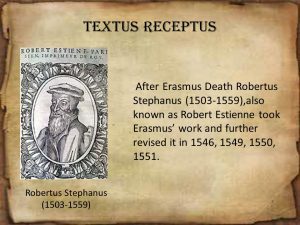 Textus Receptus agrees with the vast majority of the 86,000+ citations from scripture by the early church fathers.
Textus Receptus agrees with the vast majority of the 86,000+ citations from scripture by the early church fathers.
Textus Receptus is untainted with Egyptian philosophy and unbelief.
Textus Receptus strongly upholds the fundamental doctrines of the Christian faith: the creation account in Genesis, the divinity of Jesus Christ, the virgin birth, the Saviour’s miracles, his bodily resurrection, his literal return and the cleansing power of his blood!
Textus Receptus was (and still is) the enemy of the Roman Catholic Church. This is an important fact to bear in mind.
The existence of these manuscripts bears testimony to the Biblical account and further proof of the voracity of the Bible Texts.
Archaeological Evidence.
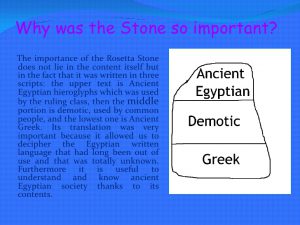 Again and again archaeological discoveries have verified the accuracy of the historical and cultural references in the Bible. The more they dig, the more it confirms the Bible. “It is important to note that Near Eastern archaeology has demonstrated the historical and geographical reliability of the Bible in many important areas.” E.M. Blaiklock,
Again and again archaeological discoveries have verified the accuracy of the historical and cultural references in the Bible. The more they dig, the more it confirms the Bible. “It is important to note that Near Eastern archaeology has demonstrated the historical and geographical reliability of the Bible in many important areas.” E.M. Blaiklock,
This article first appeared in the Christian Research Journal, volume 27, number 2 (2004). For further information or to subscribe to the Christian Research Journal go to: http://www.equip.org
Archaeological finds that contradict the contentions of biblical minimalists and other revisionists have been listed above. There are many more, however, that corroborate biblical evidence, and the following list provides only the most significant discoveries:
A Common Flood Story. Not just the Hebrews (Gen. 6–8), but Mesopotamians, Egyptians, and Greeks all report a flood in primordial times. A Sumerian king list from c. 2100 BC divides itself into two categories: those kings who ruled before a great flood and those who ruled after it. One of the earliest examples of Sumero-Akkadian-Babylonian literature, the Gilgamesh Epic, describes a great flood sent as punishment by the gods, with humanity saved only when the pious Utnapishtim (AKA, “the Mesopotamian Noah”) builds a ship and saves the animal world thereon. A later Greek counterpart, the story of Deucalion and Phyrra, tells of a couple who survived a great flood sent by an angry Zeus. Taking refuge atop Mount Parnassus (AKA, “the Greek Ararat”), they supposedly repopulated the earth by heaving stones behind them that sprang into human beings.
The Code of Hammurabi. This seven-foot black diorite stele, discovered at Susa and presently located in the Louvre museum, contains 282 engraved laws of Babylonian King Hammurabi (fl. 1750 BC). The common basis for this law code is the lex talionis (“the law of the tooth”), showing that there was a common Semitic law of retribution in the ancient Near East, which is clearly reflected in the Pentateuch. Exodus 21:23–25, for example, reads: “But if there is serious injury, you are to take life for life, eye for eye, tooth for tooth, hand for hand, foot for foot…” (niv).
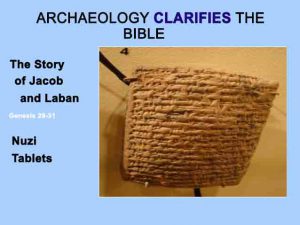 The Nuzi Tablets. The some 20,000 cuneiform clay tablets discovered at the ruins of Nuzi, east of the Tigris River and datable to c. 1500 BC, reveal institutions, practices, and customs remarkably congruent to those found in Genesis. These tablets include treaties, marriage arrangements, rules regarding inheritance, adoption, and the like.
The Nuzi Tablets. The some 20,000 cuneiform clay tablets discovered at the ruins of Nuzi, east of the Tigris River and datable to c. 1500 BC, reveal institutions, practices, and customs remarkably congruent to those found in Genesis. These tablets include treaties, marriage arrangements, rules regarding inheritance, adoption, and the like.
The Existence of Hittites. Genesis 23 reports that Abraham buried Sarah in the Cave of Machpelah, which he purchased from Ephron the Hittite. Second Samuel 11 tells of David’s adultery with Bathsheba, the wife of Uriah the Hittite. A century ago the Hittites were unknown outside of the Old Testament, and critics claimed that they were a figment of biblical imagination. In 1906, however, archaeologists digging east of Ankara, Turkey, discovered the ruins of Hattusas, the ancient Hittite capital at what is today called Boghazkoy, as well as its vast collection of Hittite historical records, which showed an empire flourishing in the mid-second millennium BC. This critical challenge, among many others, was immediately proved worthless — a pattern that would often be repeated in the decades to come.
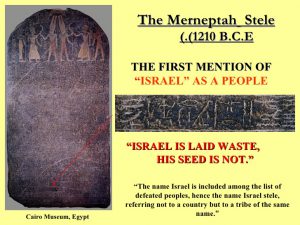 The Merneptah Stele. A seven-foot slab engraved with hieroglyphics, also called the Israel Stele, boasts of the Egyptian pharaoh’s conquest of Libyans and peoples in Palestine, including the Israelites: “Israel — his seed is not.” This is the earliest reference to Israel in nonbiblical sources and demonstrates that, as of c. 1230 BC, the Hebrews were already living in the Promised Land.
The Merneptah Stele. A seven-foot slab engraved with hieroglyphics, also called the Israel Stele, boasts of the Egyptian pharaoh’s conquest of Libyans and peoples in Palestine, including the Israelites: “Israel — his seed is not.” This is the earliest reference to Israel in nonbiblical sources and demonstrates that, as of c. 1230 BC, the Hebrews were already living in the Promised Land.
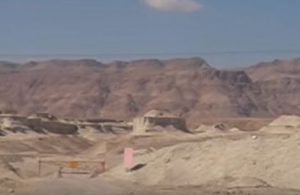 Biblical Cities Attested Archaeologically. In addition to Jericho, places such as Sodom and Gomorrah, Haran, Hazor, Dan, Megiddo, Shechem, Samaria, Shiloh, Gezer, Gibeah, Beth Shemesh, Beth Shean, Beersheba, Lachish, and many other urban sites have been excavated, quite apart from such larger and obvious locations as Jerusalem or Babylon. Such geographical markers are extremely significant in demonstrating that fact, not fantasy, is intended in the Old Testament historical narratives; otherwise, the specificity regarding these urban sites would have been replaced by “Once upon a time” narratives with only hazy geographical parameters, if any.
Biblical Cities Attested Archaeologically. In addition to Jericho, places such as Sodom and Gomorrah, Haran, Hazor, Dan, Megiddo, Shechem, Samaria, Shiloh, Gezer, Gibeah, Beth Shemesh, Beth Shean, Beersheba, Lachish, and many other urban sites have been excavated, quite apart from such larger and obvious locations as Jerusalem or Babylon. Such geographical markers are extremely significant in demonstrating that fact, not fantasy, is intended in the Old Testament historical narratives; otherwise, the specificity regarding these urban sites would have been replaced by “Once upon a time” narratives with only hazy geographical parameters, if any.
Israel’s enemies in the Hebrew Bible likewise are not contrived but solidly historical. Among the most dangerous of these were the Philistines, the people after whom Palestine itself would be named. Their earliest depiction is on the Temple of Rameses III at Thebes, c. 1150 BC, as “peoples of the sea” who invaded the Delta area and later the coastal plain of Canaan. The Pentapolis (five cities) they established — namely Ashkelon, Ashdod, Gaza, Gath, and Ekron — have all been excavated, at least in part, and some remain cities to this day. Such precise urban evidence measures favorably when compared with the geographical sites claimed in the holy books of other religious systems, which often have no basis whatever in reality.10
Shishak’s Invasion of Judah. First Kings 14 and 2 Chronicles 12 tell of Pharaoh Shishak’s conquest of Judah in the fifth year of the reign of King Rehoboam, the brainless son of Solomon, and how Solomon’s temple in Jerusalem was robbed of its treasures on that occasion. This victory is also commemorated in hieroglyphic wall carvings on the Temple of Amon at Thebes.
The Moabite Stone. Second Kings 3 reports that Mesha, the king of Moab, rebelled against the king of Israel following the death of Ahab. A three-foot stone slab, also called the Mesha Stele, confirms the revolt by claiming triumph over Ahab’s family, c. 850 BC, and that Israel had “perished forever.”
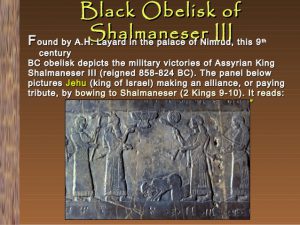 Obelisk of Shalmaneser III. In 2 Kings 9–10, Jehu is mentioned as King of Israel (841–814 BC). That the growing power of Assyria was already encroaching on the northern kings prior to their ultimate conquest in 722 BC is demonstrated by a six-and-a-half-foot black obelisk discovered in the ruins of the palace at Nimrud in 1846. On it, Jehu is shown kneeling before Shalmaneser III and offering tribute to the Assyrian king, the only relief we have to date of a Hebrew monarch.
Obelisk of Shalmaneser III. In 2 Kings 9–10, Jehu is mentioned as King of Israel (841–814 BC). That the growing power of Assyria was already encroaching on the northern kings prior to their ultimate conquest in 722 BC is demonstrated by a six-and-a-half-foot black obelisk discovered in the ruins of the palace at Nimrud in 1846. On it, Jehu is shown kneeling before Shalmaneser III and offering tribute to the Assyrian king, the only relief we have to date of a Hebrew monarch.
Burial Plaque of King Uzziah. Down in Judah, King Uzziah ruled from 792 to 740 BC, a contemporary of Amos, Hosea, and Isaiah. Like Solomon, he began well and ended badly. In 2 Chronicles 26 his sin is recorded, which resulted in his being struck with leprosy later in life. When Uzziah died, he was interred in a “field of burial that belonged to the kings.” His stone burial plaque has been discovered on the Mount of Olives, and it reads: “Here, the bones of Uzziah, King of Judah, were brought. Do not open.”
Hezekiah’s Siloam Tunnel Inscription. King Hezekiah of Judah ruled from 721 to 686 BC. Fearing a siege by the Assyrian king, Sennacherib, Hezekiah preserved Jerusalem’s water supply by cutting a tunnel through 1,750 feet of solid rock from the Gihon Spring to the Pool of Siloam inside the city walls (2 Kings 20; 2 Chron. 32). At the Siloam end of the tunnel, an inscription, presently in the archaeological museum at Istanbul, Turkey, celebrates this remarkable accomplishment. The tunnel is probably the only biblical site that has not changed its appearance in 2,700 years.
 The Sennacherib Prism. After having conquered the 10 northern tribes of Israel, the Assyrians moved southward to do the same to Judah (2 Kings 18–19). The prophet Isaiah, however, told Hezekiah that God would protect Judah and Jerusalem against Sennacherib (2 Chron. 32; Isa. 36–37). Assyrian records virtually confirm this. The cuneiform on a hexagonal, 15-inch baked clay prism found at the Assyrian capital of Nineveh describes Sennacherib’s invasion of Judah in 701 BC in which it claims that the Assyrian king shut Hezekiah inside Jerusalem “like a caged bird.” Like the biblical record, however, it does not state that he conquered Jerusalem, which the prism certainly would have done had this been the case. The Assyrians, in fact, bypassed Jerusalem on their way to Egypt, and the city would not fall until the time of Nebuchadnezzar and the Neo-Babylonians in 586 BC. Sennacherib himself returned to Nineveh where his own sons murdered him.
The Sennacherib Prism. After having conquered the 10 northern tribes of Israel, the Assyrians moved southward to do the same to Judah (2 Kings 18–19). The prophet Isaiah, however, told Hezekiah that God would protect Judah and Jerusalem against Sennacherib (2 Chron. 32; Isa. 36–37). Assyrian records virtually confirm this. The cuneiform on a hexagonal, 15-inch baked clay prism found at the Assyrian capital of Nineveh describes Sennacherib’s invasion of Judah in 701 BC in which it claims that the Assyrian king shut Hezekiah inside Jerusalem “like a caged bird.” Like the biblical record, however, it does not state that he conquered Jerusalem, which the prism certainly would have done had this been the case. The Assyrians, in fact, bypassed Jerusalem on their way to Egypt, and the city would not fall until the time of Nebuchadnezzar and the Neo-Babylonians in 586 BC. Sennacherib himself returned to Nineveh where his own sons murdered him.
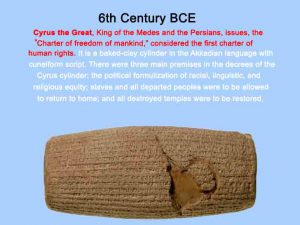 The Cylinder of Cyrus the Great. Second Chronicles 36:23 and Ezra 1 report that Cyrus the Great of Persia, after conquering Babylon, permitted Jews in the Babylonian Captivity to return to their homeland. Isaiah had even prophesied this (Isa. 44:28). This tolerant policy of the founder of the Persian Empire is borne out by the discovery of a nine-inch clay cylinder found at Babylon from the time of its conquest, 539 BC, which reports Cyrus’s victory and his subsequent policy of permitting Babylonian captives to return to their homes and even rebuild their temples.
The Cylinder of Cyrus the Great. Second Chronicles 36:23 and Ezra 1 report that Cyrus the Great of Persia, after conquering Babylon, permitted Jews in the Babylonian Captivity to return to their homeland. Isaiah had even prophesied this (Isa. 44:28). This tolerant policy of the founder of the Persian Empire is borne out by the discovery of a nine-inch clay cylinder found at Babylon from the time of its conquest, 539 BC, which reports Cyrus’s victory and his subsequent policy of permitting Babylonian captives to return to their homes and even rebuild their temples.
So it goes. This list of correlations between Old Testament texts and the hard evidence of Near Eastern archaeology could easily be tripled in length. When it comes to the intertestamental and New Testament eras, as we might expect, the needle on the gauge of positive correlations simply goes off the scale.
To use terms such as “false testament” for the Hebrew Bible and to vaporize its earlier personalities into nonexistence accordingly has no justification whatever in terms of the mass of geographical, archaeological, and historical evidence that correlates so admirably with Scripture.
LET’S REVISE THE REVISIONISM
In view of the overwhelming evidence, to banner an article in Harper’s as “False Testament” when referring to the Hebrew Bible is clearly an outrage. A cartoon in that article, showing the Bible being eaten away with vast corridors cut through its text, is an appropriately false caricature that goes with the rest of the article.
This, however, is quite typical of the way biblical matters are reported in today’s news media. An extraordinary archaeological discovery that confirms the biblical record barely receives any notice in the press, as witness the bones of the first biblical personality ever discovered in November, 1990. Generally, only one in a hundred know that the remains of Joseph Caiaphas, the high priest who indicted Jesus before Pontius Pilate on Good Friday, were found at that time in an ossuary in the Peace Forest of Jerusalem south of the Temple area. Let sensation-seeking writers claim, however, that the patriarchs were mythical, that David was a petty hilltop chieftain if he existed at all, that Jesus married Mary Magdalene, or that God predicted the assassination of Israeli premier Itzhaak Rabin through some arcane Bible code (yet did nothing about it), and the press covers it sympathetically and in full. In no way is this fair, ethical, or even logical.
Nor is the press alone in this deception. Radical revisionist biblical scholars and pseudoscholars, like members of the notorious Jesus Seminar, are well aware of this sad sensationalizing formula for success and exploit it regularly. This may, admittedly, be impugning the motives of some in that category who are driven instead by a desire merely to be “politically correct” when it comes to biblical scholarship; that is, to be ultracritical of anything biblical. In this connection, sadly, secular historians of the ancient world often have a much higher opinion of the reliability of biblical sources than some biblical scholars themselves!
Lest this critique be written off as the meaningless chatter of some conservative curmudgeon, however, I must point out that, in fact, it represents the majority view in biblical scholarship today. University of Arizona archaeologist William Dever, for example, is well known for his objection to the term “biblical archaeology,” since it seems to convey a probiblical bias; yet he assails some of the unwarranted conclusions of biblical minimalists in a strongly worded article in BAR: “Save Us from Postmodern Malarkey.”11 He does not have kind words for the minimalists in his book, What Did the Biblical Writers Know and When Did They Know It? either. “I suggest,” he writes, “that the revisionists are nihilist not only in the historical sense but also in the philosophical and moral sense.”12
BAR, which provides the literary arena for the traditionalist vs. minimalist battles and tries to keep a neutral stance in the process, similarly found the Harper’s article to be “only one side of a very hot debate in the field. Nowhere does [the author] try to evaluate the merits of the other side’s case. In fact he gives no indication that he’s even aware there is another side.”13
Let the debate continue, but let all the evidence be admitted. Ever since scientific archaeology started a century and a half ago, the consistent pattern has been this: the hard evidence from the ground has borne out the biblical record again and again — and again. The Bible has nothing to fear from the spade.
notes
1. Israel Finkelstein and Neil Asher Silberman, The Bible Unearthed: Archaeology’s New Vision of Ancient Israel and the Origin of Its Sacred Texts (New York: The Free Press, 2001).
2. Daniel Lazare, “False Testament: Archaeology Refutes the Bible’s Claim to History,” Harper’s, March 2002, 39–47.
3. Ibid., 40.
4. See Kenneth Kitchen, “The Patriarchal Age: Myth or History?” Biblical Archaeology Review(hereafter BAR), March/April 1995, 48ff.
5. A considerable, and growing, body of literature exists on the Hebrews in Egypt, the role of Joseph, the pharaoh who befriended him, the Hyksos, the pharaoh of the Oppression, the pharaoh of the Exodus, and the Exodus itself. See recent issues of Bible and Spade, especially no. 16 (Winter 2003). Joseph P. Free and Howard F. Vos, Archaeology and Bible History (Grand Rapids: Zondervan Publishing House, 1992), 69–105 is also helpful, as is Alfred J. Hoerth,Archaeology and the Old Testament (Grand Rapids: Baker Book House, 1999).
6. Kathleen M. Kenyon, Digging up Jericho (London: Ernest Benn, 1957); Excavations at Jericho, vol. 3 (London: British School of Archaeology in Jerusalem, 1981).
7. Bryant G. Wood, “Did the Israelites Conquer Jericho?” BAR, March/April 1990, 44–58.
8. Lazare, 45–46.
9. Hershel Shanks, “Biran at Ninety,” BAR, September/October 1999, 44.
10. For example, in The Book of Mormon, proper names of places and people have no substantiation from outside sources.
11. William A. Dever, “Save Us from Postmodern Malarkey,” BAR, March/April 2000, 28.
12. William A. Dever, cited in Gordon Govier, “Biblical Archaeology’s Dusty Little Secret,”Christianity Today, October 2003, 38.
13. Steven Feldman, “Is the Bible a Bunch of Historical Hooey?” BAR, May/June 2002, 6.
Eyewitness Accounts.
The Bible was written by people who witnessed the events it describes; many were persecuted or martyred but never changed their story. Would you die for something you knew was untrue? “It is no moderate approbation of Scripture that it has been sealed by the blood of so many witnesses, especially when we reflect that they died to render testimony to the faith …with a firm and constant, yet sober, zeal toward God.” John Calvin
The following was published by J Warner Wallace in an artical December 11, 2013 at http://coldcasechristianity.com/
I often wonder precisely when the disciples of Jesus realized their important role in Christian History. As these men sat at the feat of Jesus and listened to everything He had to say, did they realize they would someday testify to everything He said and did? Most eyewitnesses I’ve interviewed in my casework had no idea they would later be called into a jury trial to testify about what they heard or observed. As a result, they sometimes regret not paying better attention when they had the opportunity. But the disciples of Jesus had a distinct advantage over modern eyewitnesses in this regard. They were students of Jesus. Unlike spontaneous, unprepared witnesses of a crime, the disciples were desperately attentive to the words and actions of Jesus, and I imagine their attention to detail became even more focused with each miraculous event. For this reason, the authors of the gospels became excellent eyewitnesses and recognized the importance of their testimony very early.
While Jesus walked here on earth, His followers studied and learned from His actions and words. They were often mesmerized, confused and challenged by what they saw and heard. In spite of this, Jesus taught them and occasionally sent them out on their own. They memorized His teaching and relied on his wisdom when they weren’t with Him. We don’t know how much (if anything) these eyewitnesses wrote down during this time. Did the disciples take notes? Did they keep a journal? While Jesus was alive, the disciples likely felt no need to write down his words. The Word was witnessed in these incredible days, as men and women stood in awe of the Master, watching Him perform miracles and listening carefully to what He taught about God and eternal life.
During the first years following Jesus’s ascension, the apostles still may not have written immediately about Jesus. Why not? A careful reading of the Scripture will reveal a common theme: Many of the early authors of the New Testament expected Jesus to return before there would ever be a need for a multi-generational eyewitness record. They worked urgently to tell the world about Jesus, believing He would return to judge the living and the dead within their lifetime. In the days of the Apostles, the Word washeard, as the apostles preached to the world around them. But as the Apostles began to be martyred (and those who remained realized Jesus might not return in their lifetime), the need for a written account became clear. James, the brother of John was killed in 44AD (Stephen was killed even earlier), and not long afterward, the gospels began to emerge. The eyewitness gospel authors wrote down what they had seen so the world would have a record.
Following the deaths of the apostles, the early believers and leaders received the apostolic eyewitness accounts and regarded them as sacred. They knew the original eyewitnesses had vanished from the scene and they wanted to retain a faithful record of their testimony. From the earliest of times, these Christians coveted the New Testament writings. In the days of the early Church Fathers, the Word was read, as the sacred Gospels and letters were carefully protected. The earliest believers accepted the gospels and letters of the New Testament as eyewitness accounts because the authors of these texts considered their own writing to be authoritative, eyewitness Scripture:
1 Peter 5:1
Therefore, I exhort the elders among you, as your fellow elder and witness of the sufferings of Christ, and a partaker also of the glory that is to be revealed…
2 Peter 1:16-17
For we did not follow cleverly devised tales when we made known to you the power and coming of our Lord Jesus Christ, but we were eyewitnesses of His majesty.
1 John 1:1-3
What was from the beginning, what we have heard, what we have seen with our eyes, what we have looked at and touched with our hands, concerning the Word of Life – and the life was manifested, and we have seen and testify and proclaim to you the eternal life, which was with the Father and was manifested to us – what we have seen and heard we proclaim to you also, so that you too may have fellowship with us…
The apostles understood their experiences as eyewitnesses were unique, and they called for these eyewitness accounts to be read by all believers. Paul recognized both the Old Testament writings and the New Testament writings were sacred and God-given. He considered both to be Scripture:
1 Timothy 5:17-18
The elders who direct the affairs of the church well are worthy of double honor, especially those whose work is preaching and teaching. For the Scripture says, ‘Do not muzzle the ox while it is treading out the grain,’ and ‘The worker deserves his wages.’
In this passage, Paul quoted both Deuteronomy 25:4 and Luke 10:7 (“The worker deserves his wages”). He referred to both passages as Scripture. It’s clear the New Testament Gospels were already in place at the time of this writing, and it’s also clear that believers were reading these Gospels as Scripture. Peter also attested to Paul’s writings as Scripture when writing his own letters to the early Church:
2 Peter 3:14-16
Bear in mind that our Lord’s patience means salvation, just as our dear brother Paul also wrote you with the wisdom that God gave him. He writes the same way in all his letters, speaking in them of these matters. His letters contain some things that are hard to understand, which ignorant and unstable people distort, as they do the other Scriptures, to their own destruction.
In addition to this, it is clear the New Testament letters were being read and circulated among the churches as authoritative eyewitness Scripture and revelation from God:
Colossians 4:16
After this letter has been read to you, see that it is also read in the church of the Laodiceans and that you in turn read the letter from Laodicea.
1 Thessalonians 5:27
I charge you before the Lord to have this letter read to all the brothers.
The eyewitness authors of the New Testament gospels and letters understood the power of their testimony. They witnessed the Word in the days when a written record was unnecessary, spoke the Word when they thought Jesus would return imminently, and wrote the Word when they realized theireyewitness record would become Scripture for those who followed them. That’s how the ancient eyewitness accounts became the New Testament Scripture we cherish today.
J. Warner Wallace is a Cold-Case Detective, a Christian Case Maker, and the author of Cold-Case Christianity
Comment or Subscribe to J. Warner’s Daily Email
Corroborating Accounts.
There are plenty of references in non-biblical sources to the events described in the Bible. The Jewish historian Josephus, born in 37 AD, “provide(s) indispensable background material for the student of…New Testament history. In them, we meet many figures well known to us from the New Testament. Some of his writings provide direct commentary on New Testament references.” J.D. Douglas, ed.
Also Pliny the Younger: (AD 61)Another important source of evidence for Jesus and early Christianity can be found in his letters to Emperor Trajan.Pliny was the Roman governor of Bithynia in Asia Minor. In one of his letters, dated around A.D. 112, he asks Trajan’s advice about the appropriate way to conduct legal proceedings against those accused of being Christians. Pliny says that he needed to consult the emperor about this issue because a great multitude of every age, class, and sex stood accused of Christianity.
“They (The Christians) were in the habit of meeting on a certain fixed day before it was light, when they sang in alternate verses a hymn to Christ, as to a god, and bound themselves by a solemn oath, not to any wicked deeds, but never to commit any fraud, theft or adultery, never to falsify their word, nor deny a trust when they should be called upon to deliver it up; after which it was their custom to separate, and then reassemble to partake of food–but food of an ordinary and innocent kind.”
Also from the Babylonian Talmud: The Talmud is the body of Jewish civil and ceremonial law and legend comprising the Mishnah and the Gemara. There are two versions of the Talmud: the Babylonian Talmud and the earlier Palestinian or Jerusalem Talmud.
There are only a few clear references to Jesus in the Babylonian Talmud, a collection of Jewish rabbinical writings compiled between approximately A.D. 70-500. Given this time frame, it is naturally supposed that earlier references to Jesus are more likely to be historically reliable than later ones. In the case of the Talmud, the earliest period of compilation occurred between A.D. 70-200.{20} The most significant reference to Jesus from this period states:
On the eve of the Passover Yeshu was hanged. For forty days before the execution took place, a herald . . . cried, “He is going forth to be stoned because he has practised sorcery and enticed Israel to apostasy.
Also from Lucian: Lucian of Samosata (AD125-180) was a second century Greek satirist. In one of his works, he wrote of the early Christians as follows:
The Christians . . . worship a man to this day–the distinguished personage who introduced their novel rites, and was crucified on that account. . . . [It] was impressed on them by their original lawgiver that they are all brothers, from the moment that they are converted, and deny the gods of Greece, and worship the crucified sage, and live after his laws.
Also from Tacitus: (A.D. c.55-A.D. c.117, Roman historian) mentions “Christus” who is Jesus – Annals 15.44
“Consequently, to get rid of the report, Nero fastened the guilt and inflicted the most exquisite tortures on a class hated for their abominations, called Christians by the populace. Christus, from whom the name had its origin, suffered the extreme penalty during the reign of Tiberius at the hands of one of our procurators, Pontius Pilatus, and a most mischievous superstition, thus checked for the moment, again broke out not only in Judea, the first source of the evil, but even in Rome, where all things hideous and shameful from every part of the world find their centre and become popular.”
Ref. from http://classics.mit.edu/Tacitus/annals.mb.txt
Also from Thallus (Circa AD 52, eclipse of the sun) Thallus wrote a history of the Eastern Mediterranean world from the Trojan War to his own time. His writings are only found as citations by others. Julius Africanus, who wrote about AD 221, mentioned Thallus’ account of an eclipse of the sun.
“On the whole world there pressed a most fearful darkness; and the rocks were rent by an earthquake, and many places in Judea and other districts were thrown down. This darkness Thallus, in the third book of his History, calls, as appears to me without reason, an eclipse of the sun.”
- Is this a reference to the fearful darkness at the crucifixion? Luke 23:44-45, “And it was now about the sixth hour, and darkness fell over the whole land until the ninth hour, 45 the sun being obscured; and the veil of the temple was torn in two.”
- The oddity is that Jesus’ crucifixion occurred at the Passover which was a full moon. It is not possible for a solar eclipse to occur at a full moon. Note that Julius Africanus draws the conclusion that Thallus’ mentioning of the eclipse was describing the one at Jesus’ crucifixion. It may not have been.
- Julius Africanus, Extant Writings, XVIII in the Ante Nicene Fathers, ed. by Alexander Roberts and James Donaldson (Grand Rapids: Eerdmans, 1973), vol. VI, p. 130. as cited in Habermas, Gary R., The Historical Jesus: Ancient Evidence for the Life of Christ, (Joplin, MO: College Press Publishing Company) 1996.
Literary Consistency.
The Bible contains 66 books written over 1,600 years in three languages, by approximately 40 different writers, but they tell of one story, the plan of redemption, and one person, Christ Jesus. Try playing a game of silent whispers and see what the end result is. The harmony in the writings of the many and varied Bible authors over the years bears testimony to the consistency of the messages therein, and the Divine inspiration provided to these writers.
Prophetic Consistency.
As mentioned above there are some 353 specific prophecies in the Old Testament that are fulfilled in the life, death and resurrection of Jesus Christ in the New Testament. “The very dimension of the sheer fulfillment of prophecy of the Old Testament Scriptures should be enough to convince even the most pessimistic mind that we are dealing with a Divinely Inspired piece of literature….God Himself has provided consistency of message, and of prophecy that bears witness to His Authorship of the Heavens and the Earth.
The Bible unfolds truth with a simplicity and an adaptation to the needs and longings of the human heart, that has astonished and charmed the most highly cultivated minds, while to the humble and uncultured, it also makes plain the way of life. “The wayfaring men, tho fools, shall not err therein.” No child need mistake the path. Not one trembling seeker need fail of walking in pure and holy light. Yet the most simply-stated truths lay hold upon themes elevated, far-reaching, infinitely beyond the power of human comprehension,—mysteries that are the hiding of His glory,—mysteries that overpower the mind in its research, while they inspire the sincere seeker for truth with reverence and faith. The more we search the Bible, the deeper is our conviction that it is the Word of the living God, and human reason bows before the majesty of divine wisdom. E. G. White The Sign of the Times April 25, 1906

No comments:
Post a Comment